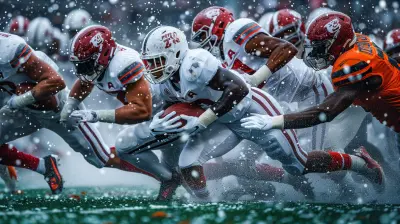13 March 2025
Sports strategies come and go, but some stick around because they completely redefine how the game is played. One such tactical trend that has managed to grab the limelight in recent years is the high-press strategy. If you're a football fan, you've likely heard pundits rave about it, coaches preach it, and players relentlessly execute it on the pitch. But was it really the winning formula?
In this article, we’ll dive deep into the high-press strategy, exploring what it is, how it works, its advantages and limitations, and whether it truly holds the key to success in modern football. So, buckle up and get ready to press high into the world of football tactics!

What is the High-Press Strategy?
First things first, let’s break it down. The high-press strategy is all about applying intense pressure on the opponent high up the pitch—in their own defensive third. Instead of waiting for the opposing team to bring the ball into your half, you go after them, like a pack of wolves hunting down their prey. The idea is simple: win the ball back as quickly as possible and close to the opponent’s goal, giving your team a greater chance of scoring.Think of it like playing chess, but instead of waiting for your opponent to make a move, you’re already in their face, forcing them into mistakes. Sounds aggressive, right? Well, it is. And that's also part of its appeal.

The Evolution of the High-Press
While it may seem like a recent tactical innovation, the high-press strategy has its roots in older styles of football. Historically, many teams adopted a more defensive approach, sitting back and waiting for counter-attacking opportunities. But with the rise of teams like Pep Guardiola's Barcelona and Jürgen Klopp's Borussia Dortmund and Liverpool, the high-press became a new trend.To understand its evolution, we can't ignore the influence of "Gegenpressing," a term popularized by Klopp. Gegenpressing translates to "counter-pressing," which means pressing immediately after losing possession to regain control. Klopp has always been vocal about this, often describing it as "the best playmaker" because if done correctly, it gets the ball back in dangerous areas where scoring opportunities abound.
Other notable teams like Marcelo Bielsa's Leeds United and Diego Simeone's Atlético Madrid have also employed variations of the high-press strategy, proving that it’s not confined to just one style of play.

How Does the High-Press Work?
Now that we’ve got the background out of the way, let’s talk about the mechanics of the high-press.1. Positioning
The key to a successful high-press starts with positioning. Teams that press high up the pitch need to be compact and organized. The forwards and midfielders position themselves close to the opposing defenders, seeking any opportunity to close down passing lanes.2. Trigger Points
High-press teams often have specific moments, known as "triggers," where the press is ignited. For instance, when the ball is played to a specific opponent (like a full-back or center-back) or when the opposing team makes a backward pass, that’s the cue to press aggressively.3. Pressure in Packs
A single player pressing won’t cut it. Pressing works like a swarm; multiple players press simultaneously to suffocate the ball carrier and force the opposing team into mistakes. The more the players work in sync, the more likely it is they’ll win back possession.4. Cutting Off Passing Lanes
One of the crucial aspects of the high-press is limiting the options for the ball carrier. It’s not just about running at the player with the ball; it’s also about cutting off their passing options, forcing them to make a rushed decision—ideally a mistake or a turnover.
Why the High-Press Became So Popular
The high-press strategy gained massive popularity, especially with teams that wanted to dominate possession and maintain control of the game. But why did coaches fall in love with it?a) Forcing Mistakes
The biggest advantage of the high-press is that it forces the opponent into making mistakes. When you pressure a player, they have less time to think, and as we all know, rushed decisions often lead to errors. And what happens when you win the ball in the opponent’s half? You're already in a dangerous position to create a goal-scoring opportunity.b) Disrupting the Opponent's Rhythm
By pressing high, you prevent the opposing team from settling into their rhythm. They can't comfortably build play from the back or move the ball around at will. It’s like cutting their engine before they even get started.c) Quick Transitions
When you win the ball high up the pitch, you're already within striking distance of the opponent's goal. This allows for quick transitions and fast attacks. You don’t have to build from the back; you're already in an advanced position.d) Mental Pressure
High-pressing can also have a psychological effect on the opposition. Constant pressure can leave the opposing team feeling unsettled, mentally fatigued, and prone to errors. It’s similar to boxing—if your opponent is always on the ropes, they’re more likely to slip up.When the High-Press Works
The high-press isn’t a one-size-fits-all solution. Several factors determine whether it will succeed or flop. Let’s take a look at the scenarios where the high-press shines.1. Against Possession-Based Teams
The high-press works particularly well against possession-based teams that like to play out from the back. By applying pressure on their defenders and midfielders, you can force them into mistakes and prevent them from building their usual patterns of play.2. Physically Fit Teams
Pressing requires an incredible amount of energy. Teams that are physically fit and have high stamina can maintain the press for longer periods, preventing the opposition from ever finding their footing. Take Klopp’s Liverpool, for example—they press relentlessly for the full 90 minutes.3. Aggressive and Organized Teams
For the high-press to be effective, the entire team needs to be on the same page. If one player presses and the others don’t, it leaves gaps that the opposition can exploit. Teams that are well-drilled in this tactic and move as a unit can suffocate their opponents and force turnovers.The Limitations of the High-Press
While the high-press can be an incredibly effective strategy, it’s not without its drawbacks. Like any tactical approach, it has its risks and limitations.a) Energy-Intensive
Pressing high up the pitch for 90 minutes is exhausting. It requires extreme fitness levels and stamina. Teams that can’t maintain this level of intensity often suffer in the later stages of the game, leaving them vulnerable to counter-attacks.b) Vulnerable to Quick Counters
When you press high, you leave space behind your defensive line. Opponents that can quickly bypass the press with long balls or swift passing combinations can exploit this space and launch dangerous counter-attacks. This is especially risky against teams with fast forwards.c) Requires High Defensive Discipline
Not only do the forwards and midfielders need to press, but the defenders also need to be prepared to step up and close down space. If the defense isn’t organized or leaves gaps, the opposition can break through easily.d) Not Effective Against Direct Teams
Teams that play a more direct style of football, opting for long balls and bypassing the midfield, can neutralize the high-press. In these cases, pressing high becomes less effective, as the ball is moved too quickly for the press to have any impact.The High-Press in Modern Football: A Winning Formula?
So, is the high-press truly the winning formula? The answer is—it depends. In modern football, the high-press has proven to be a game-changing tactic. Teams like Liverpool, Manchester City, and Bayern Munich have used it to dominate both domestically and in Europe. However, it’s not a silver bullet that guarantees success.When executed properly, the high-press can suffocate opponents, force mistakes, and create goal-scoring opportunities. It’s particularly effective against teams that like to play out from the back. But it’s a double-edged sword—if your team lacks the physicality, discipline, or organization to sustain the press, it can backfire spectacularly.
In the end, the high-press is a tool in a coach’s tactical toolkit. Whether it’s the winning formula depends on how it’s implemented, the players available, and the opponents you face. Like any strategy, it has its strengths and weaknesses, and the best teams know when to use it and when to adapt.
Conclusion
The high-press strategy has revolutionized modern football, offering a new approach to dominating games and unsettling opponents. While it has clear advantages, such as forcing mistakes and quick transitions, it also comes with its own set of challenges, including the physical toll on players and vulnerability to counter-attacks.In the right hands and with the right players, the high-press can be incredibly effective. But football is a game of balance, and as with any strategy, it’s not foolproof. Was the high-press the winning formula? In many cases, yes. But it’s not the only path to victory.








Greyson Soto
The high-press strategy shows potential, but consistency and players' adaptability are key factors.
April 2, 2025 at 12:06 PM